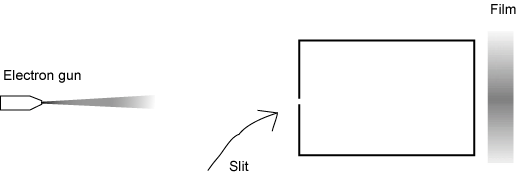
[One Slit Experiment]
Chapter 6 EXTRA: Dr. Ralph discusses the 1-slit experiment
...... ...... ......
Gedanken Today! How did the electron get THERE?
...... Dr. Ralph erased the notice. "Okay,"
he said. "Let's get right to it and consider the one-slit experiment."
...... He walked to the leftmost point of the wall-long
blackboard and drew a square. Then he rubbed the edge of the eraser across the
midpoint of the right side of the square, making a black gap. "Pretend
that this is a slit in a box." He pointed at the opposite side of the square.
"And imagine that this side is a kind of photographic film. Whenever an
electron comes through the slit and hits a point on the film, a dark spot is
made on the film--the more electrons that hit that point, the darker the spot
becomes." Dr. Ralph walked across the front of the room to the rightmost
edge of the blackboard. There he drew a little gun pointing toward the square.
"So now, every couple of milliseconds, this gun shoots out an electron.
And some of the electrons go through the slit." He walked back to the square.
"The question is," he said, looking at the class, "if after a
few days of shooting out electrons, we develop the film, what would we see?"
He glanced from face to face. "No? Okay. What we would see is a very dark
blotch directly behind the slit. And, and this is important, as we move left
or right from the darkest part of the blotch, the film will gradually get lighter."
He sketched light to dark to light with his chalk. "In fact, if we plotted
a graph of darkness against distance from the darkest point, we'd see the Gaussian
distribution we generated a few days ago. And a wide Gaussian with some points
reaching all the way to the edges of the box."

[One Slit Experiment]
...... "Why?" Dr. Ralph gave a puzzled
expression. "Any ideas? In particular, why don't all the electrons hit
at about the same place on the screen?"
...... "Well," said Wolfgang, "maybe
the electron gun doesn't always shoot electrons in the same direction."
...... "Good observation," said Dr. Ralph.
"And true, but that wouldn't explain how the paths of many electrons seem
to bend so much when they go through the slit. It's as if an electron goes through
the slit, then goes a little further, flips a coin and goes a little to the
left or right depending on heads or tails--just the way we generated the Gaussian.
And the electron keeps doing this until it reaches the screen." He shrugged.
"Does this make any sense?"
...... No one answered.
...... "Okay," said Kip. "Why does
the electron behave that way?"
...... "Well,"--Dr. Ralph juggled his
chalk--"we do have a way of talking about it, It's a map that sort of describes
the territory. But the map will turn out to be defective. So I'd rather just
say for the moment, that it's just the way small things behave."
...... Kip wrinkled his nose.
...... Dr. Ralph laughed. "Let's just say
it has something to do with waves. So tomorrow we'll have another gedanken session--on
waves."
Click here to return to Chapter 6.